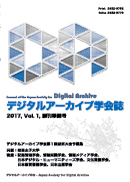Volume 5, Issue 2
Displaying 1-26 of 26 articles from this issue
- |<
- <
- 1
- >
- >|
-
2021Volume 5Issue 2 Pages j1
Published: April 01, 2021
Released on J-STAGE: June 01, 2021
Download PDF (1036K) -
2021Volume 5Issue 2 Pages j2
Published: April 01, 2021
Released on J-STAGE: June 01, 2021
Download PDF (304K)
Round Table: Digital Public Documents
-
2021Volume 5Issue 2 Pages 75
Published: April 01, 2021
Released on J-STAGE: June 01, 2021
Download PDF (718K) -
2021Volume 5Issue 2 Pages 76-80
Published: April 01, 2021
Released on J-STAGE: June 01, 2021
Download PDF (867K) -
2021Volume 5Issue 2 Pages 81
Published: April 01, 2021
Released on J-STAGE: June 01, 2021
Download PDF (723K) -
2021Volume 5Issue 2 Pages 82
Published: April 01, 2021
Released on J-STAGE: June 01, 2021
Download PDF (767K)
Feature: Practical Skills of Digital Archive
-
2021Volume 5Issue 2 Pages 83-85
Published: April 01, 2021
Released on J-STAGE: June 01, 2021
Download PDF (977K) -
2021Volume 5Issue 2 Pages 86-90
Published: April 01, 2021
Released on J-STAGE: June 01, 2021
Download PDF (1535K) -
2021Volume 5Issue 2 Pages 91-94
Published: April 01, 2021
Released on J-STAGE: June 01, 2021
Download PDF (1271K) -
2021Volume 5Issue 2 Pages 95-98
Published: April 01, 2021
Released on J-STAGE: June 01, 2021
Download PDF (1085K)
Feature: 5th Research Conference
-
2021Volume 5Issue 2 Pages 99
Published: April 01, 2021
Released on J-STAGE: June 01, 2021
Download PDF (806K) -
2021Volume 5Issue 2 Pages 100
Published: April 01, 2021
Released on J-STAGE: June 01, 2021
Download PDF (782K) -
2021Volume 5Issue 2 Pages 101-102
Published: April 01, 2021
Released on J-STAGE: June 01, 2021
Download PDF (801K) -
2021Volume 5Issue 2 Pages 103-104
Published: April 01, 2021
Released on J-STAGE: June 01, 2021
Download PDF (808K) -
2021Volume 5Issue 2 Pages 105-106
Published: April 01, 2021
Released on J-STAGE: June 01, 2021
Download PDF (838K) -
2021Volume 5Issue 2 Pages 107
Published: April 01, 2021
Released on J-STAGE: June 01, 2021
Download PDF (804K)
Mini Feature: Regional Digital Archive
-
2021Volume 5Issue 2 Pages 108
Published: April 01, 2021
Released on J-STAGE: June 01, 2021
Download PDF (714K) -
2021Volume 5Issue 2 Pages 109-111
Published: April 01, 2021
Released on J-STAGE: June 01, 2021
Download PDF (974K) -
2021Volume 5Issue 2 Pages 112-118
Published: April 01, 2021
Released on J-STAGE: June 01, 2021
Download PDF (799K)
Case Study/Research Report
-
2021Volume 5Issue 2 Pages 119-124
Published: April 01, 2021
Released on J-STAGE: June 01, 2021
Download PDF (1296K)
Advances in Digital Archive
-
2021Volume 5Issue 2 Pages 125-129
Published: April 01, 2021
Released on J-STAGE: June 01, 2021
Download PDF (1901K)
Book Reviiew
-
2021Volume 5Issue 2 Pages 130
Published: April 01, 2021
Released on J-STAGE: June 01, 2021
Download PDF (815K) -
2021Volume 5Issue 2 Pages 131
Published: April 01, 2021
Released on J-STAGE: June 01, 2021
Download PDF (823K)
-
2021Volume 5Issue 2 Pages 132-133
Published: April 01, 2021
Released on J-STAGE: June 01, 2021
Download PDF (1146K) -
2021Volume 5Issue 2 Pages 134
Published: April 01, 2021
Released on J-STAGE: June 01, 2021
Download PDF (615K) -
2021Volume 5Issue 2 Pages 135
Published: April 01, 2021
Released on J-STAGE: June 01, 2021
Download PDF (615K)
- |<
- <
- 1
- >
- >|
